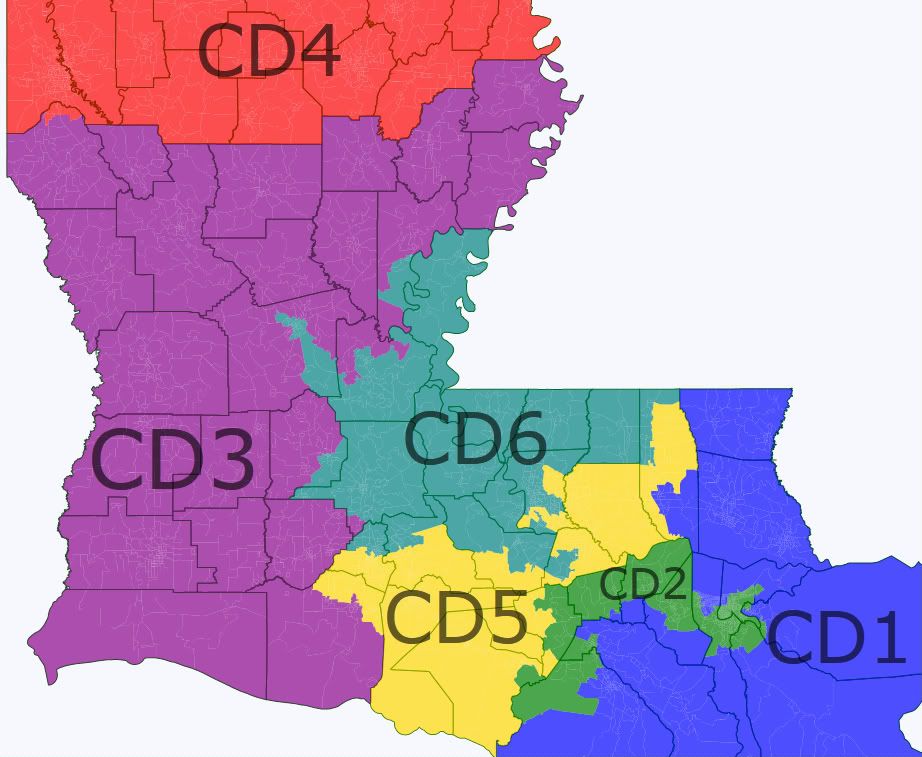A few days ago in the discussion of the proposed Louisiana map someone drew a map with two majority-black districts but nothing else filled in. I drew this map to see (a) if I could get the New Orleans district to be more compact and (b) what the other districts would look like. As it turns out, the answer to (a) is yes, but it’s plurality black as opposed to majority black, and the answer to (b) is ugly.
Here’s the map.
In district descriptions, the percentages are for voting age population. w is non-Hispanic white, b is black, h is Hispanic, and a is Asian.
LA1 (blue): 77.6w-12.3b-6.0h-1.7a. Still mostly a suburban New Orleans seat, but it was forced to move into the Thibodaux-Houma area by the positions of the VRA districts. Safe R.
LA2 (green): 41.7w-46.5b-7.3h-3.0a. Because of the depopulation of New Orleans, this district has to extend west and then south to pick up some heavily black areas. Probably likely D to safe D, as it’s still 58% minority and its white population is probably relatively moderate compared to the rest of the state. While less compact than a typical district, it’s far more compact than either its current or proposed versions.
LA3 (purple): 74.0w-20.7b-2.4h-0.9a. Ugh. It’s geographically impossible for it to take all of Cajun country, so it has to extend much further north. It wasn’t possible for it to take everything along the west side of the state up to and including Shreveport so I had to take it practically to the northeast corner of the state to avoid splitting up the Shreveport area. The result is a sprawling, incoherent mess that takes up maybe 40% of the state’s land area. Safe R.
LA4 (red): 59.8w-35.6b-2.4h-1.0a. The one clean district, the I-20 district. Likely R.
LA5 (yellow): 79.6w-13.9b-3.5h-1.7a. This ugly district with nodes in Baton Rouge and Cajun country connected by a narrow strip was necessary because the two VRA districts pass so close to each other. Safe R.
LA6 (teal): 44.6w-50.2b-2.6h-1.3a. The Baton Rouge-based majority-black district is nice and compact, but it has some community-of-interest issues as it takes pieces of Lafayette, Ville Platte, and Alexandria in addition to part of the capital city. Probably close to safe D even though it’s likely only D+6 or so: it looks like it would be easy for a Republican to get to 40% but nearly impossible to get over the hump. Compare it to Sanford Bishop’s current district, which is probably about as polarized as this LA6 would be but has black-white percentages that are basically the reverse of what this district has. It’s D+1.
I’m pretty sure that a court would accept this proposed LA6 if the state submitted it, as courts have accepted some really ugly and incoherent districts. But here’s the question: would a court compel a state to draw something like the proposed LA6–which looks ok but slices and dices some widely separated cities–if the state isn’t inclined to draw it in the first place? Perhaps someone with a better understanding of the VRA can weigh in on this. Thoughts?

than what the Republicans signed their names to in Pennsylvania, Ohio and Texas some years back. Excellent job!
It’s a little uglier than I had hoped for (based on ACS data).
the Terrebonne sections and extended into New Iberia, it would have been 50.1% black, (with a few other nitpicking tweaks here and there). It can be done. It’s just even uglier than that district is.
LA2 (green): 47.5w-38.4b-9.1h-3.5a. All of Orleans, almost all of Jefferson, including the conservative white suburbs. It’s a coalition minority-majority district. It’s 56% Obama and 55% Melancon (the 2 worst Democratic performances in Louisiana, probably ever), so it’s safe D. Even if Joseph Cao would have narrowly won it in 2010, he won’t win it back now.
LA5 (yellow): 44.8w-50.0+b-2.6h-1.3a.
There was a bill (HB41) introduced in the LA legislature with a plan for 2 Black majority districts. Of course, it didn’t go far. In that plan LA 2 has 52.7% Black; LA 6 has 52.3%. I knew roughly where they created those 2 districts, but decided to try for myself. I got LA 2 with 53.8% (centered around NO); LA 6 with 54.8% (centered around Baton Rouge).


